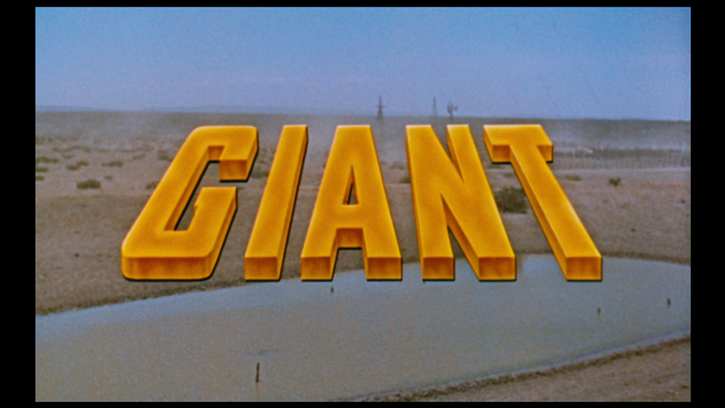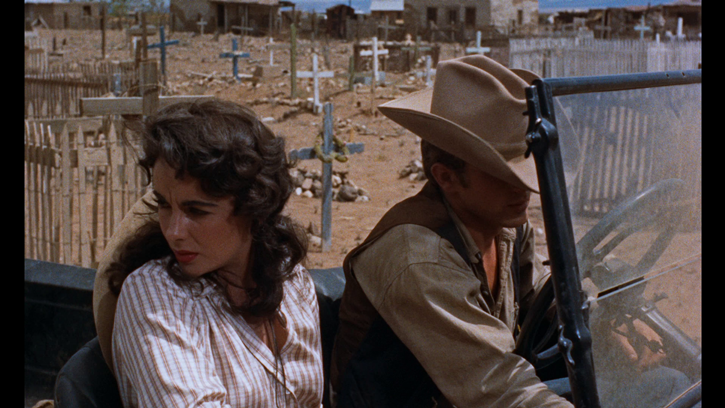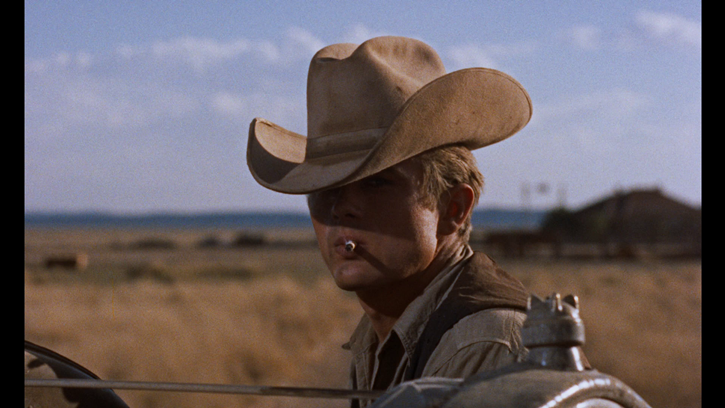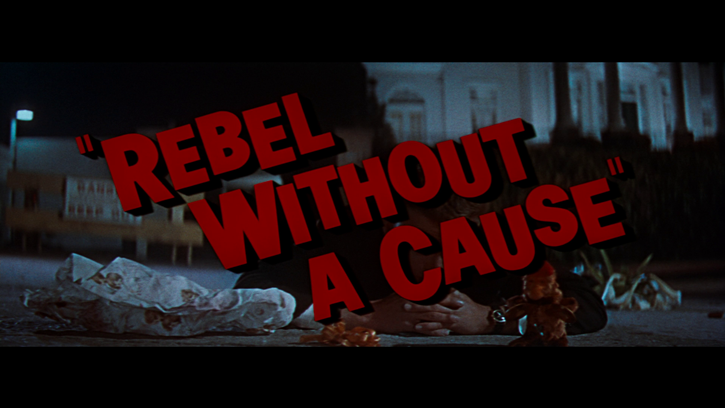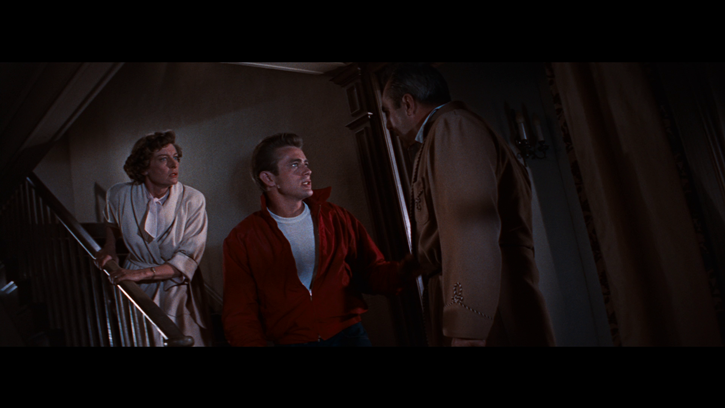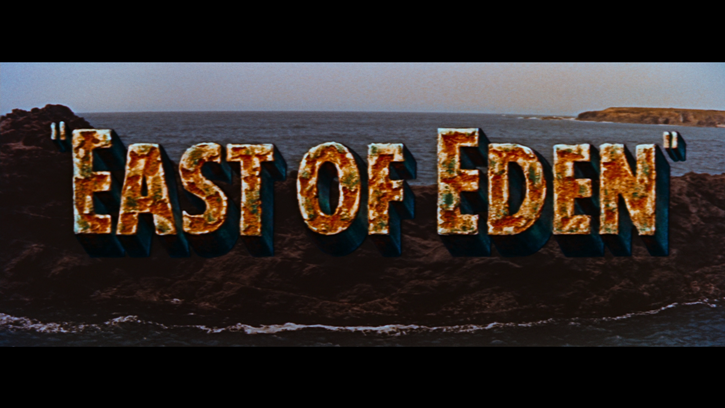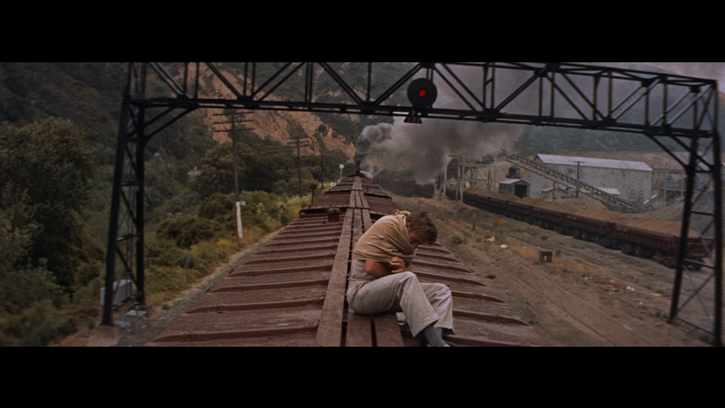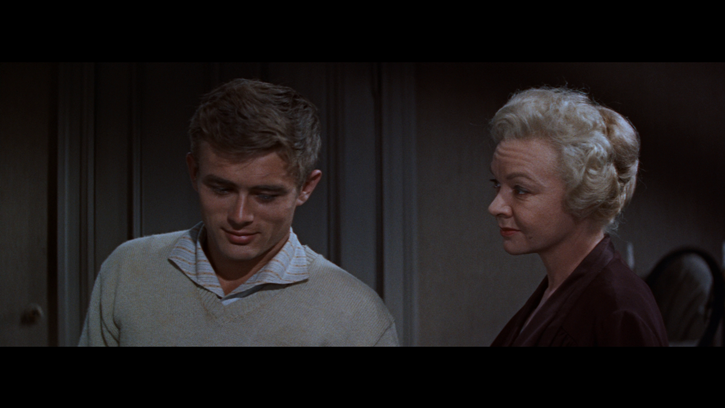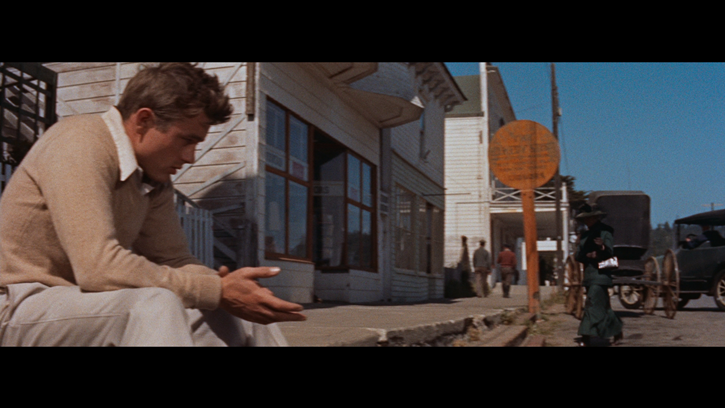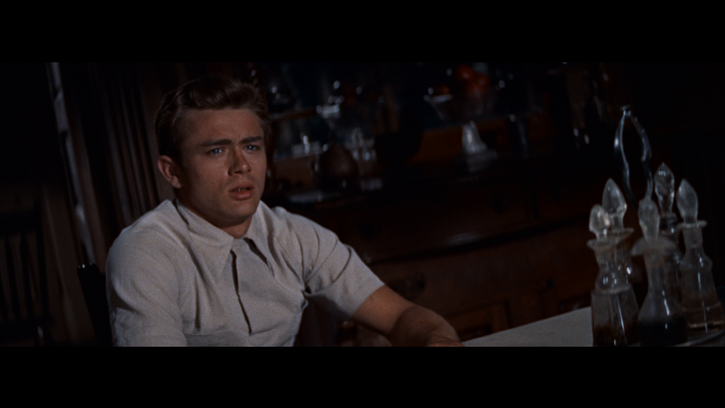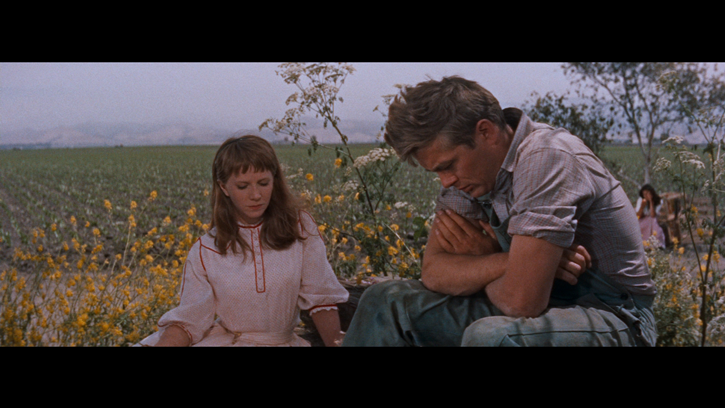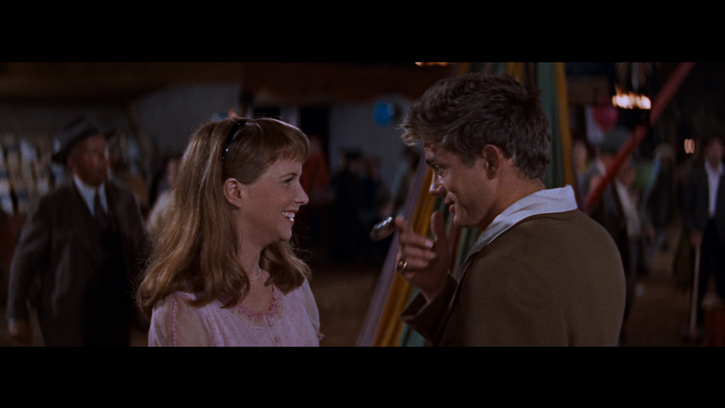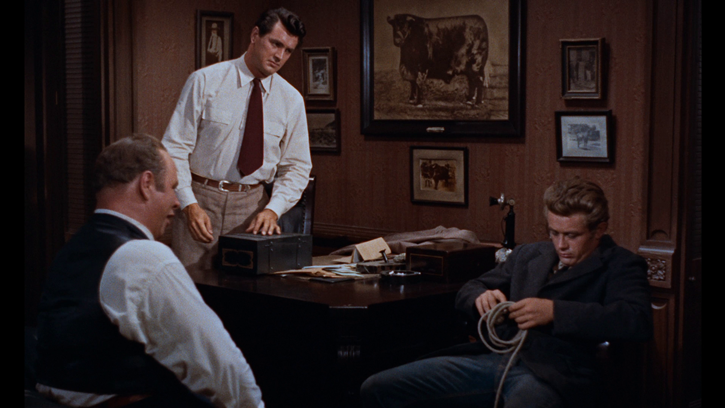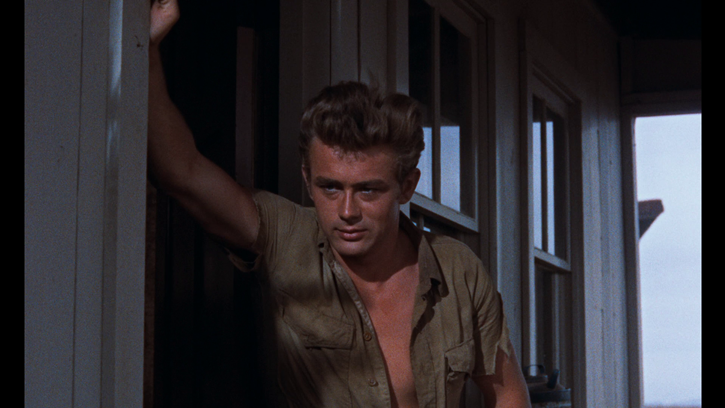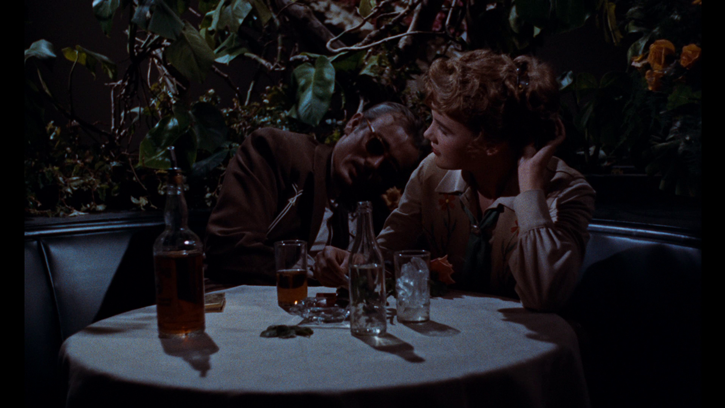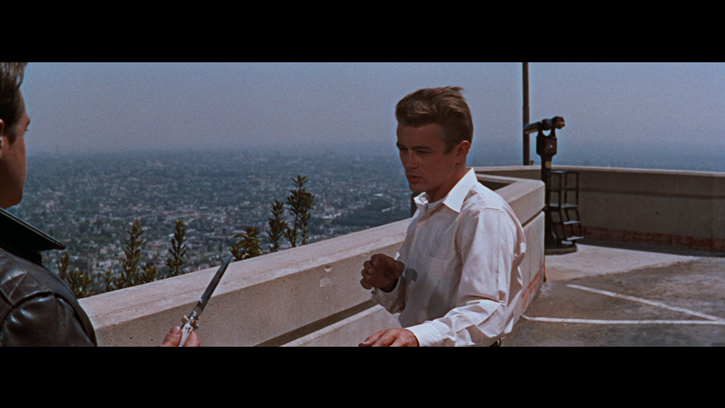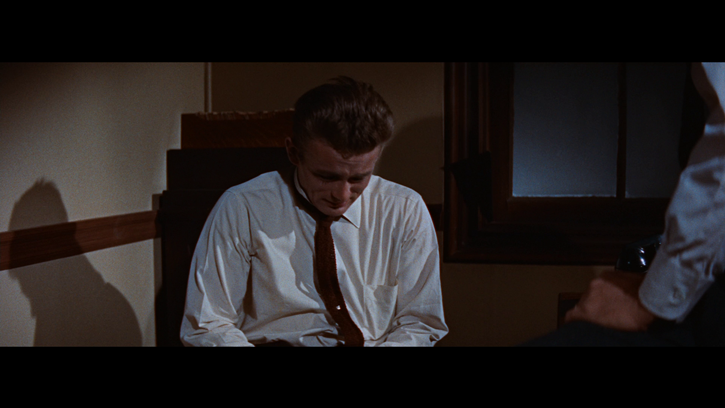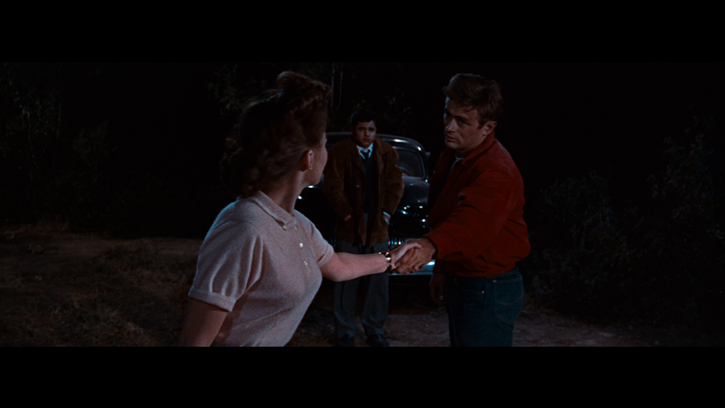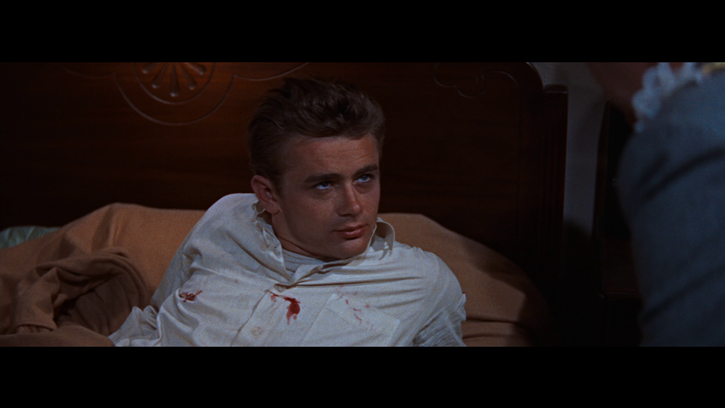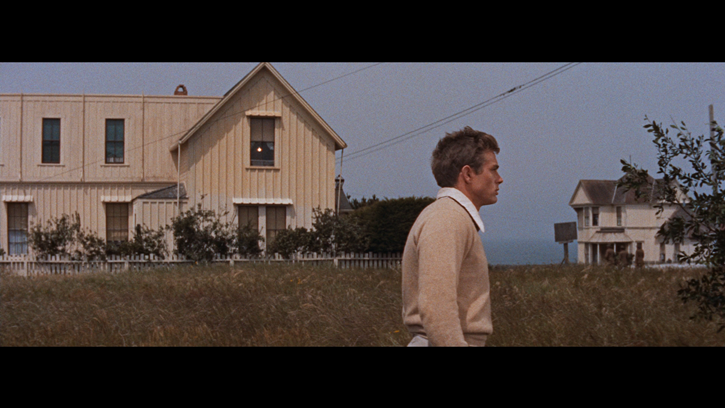| Reviews & Columns |
|
Reviews DVD TV on DVD Blu-ray 4K UHD International DVDs In Theaters Reviews by Studio Video Games Features Collector Series DVDs Easter Egg Database Interviews DVD Talk Radio Feature Articles Columns Anime Talk DVD Savant Horror DVDs The M.O.D. Squad Art House HD Talk Silent DVD
|
DVD Talk Forum |
|
|
| Resources |
|
DVD Price Search Customer Service #'s RCE Info Links |
|
Columns
|
|
|
James Dean: Ultimate Collector's Edition
Without a doubt, one of the greatest film legacies of all time resides in this one collection. Not many film releases on home media can come close to the magnitude of importance that exists with the James Dean: Ultimate Collector's Edition, which presents three masterpieces: Giant, Rebel Without a Cause, and East of Eden in newly restored editions which resulted from 4K scans of the original film negatives. For longtime fans, rediscovering these gems on Blu-ray and through these newly minted presentations is a true delight. This set is a treasure trove of art represented through filmmaking.
Two of the features in the set, Rebel Without a Cause and Giant, reside on AFI's list of the 100 Greatest American Films of All Time. East of Eden is inexplicably missing but readers should keep in mind that other films by Elia Kazan, the director of East of Eden, reside on the list. AFI's endorsement of the endurance and importance of these films is just one example of the immense impact that these films had on filmmaking and America's popular culture.
James Dean was unlike any other actors of his generation (or perhaps any other generation for that matter). There are no good comparisons. I'm sure there are many Hollywood producers hoping to find the next 'James Dean', but I am positive they haven't found the next Dean. It wouldn't be possible. He was too unique to be duplicated.
There is a good reason for his lasting legacy: the actor brought something distinctive through his performances. For starters, Dean delivered great performances and was able to demonstrate immense range. He was also a charismatic and intelligent young man who was capable of enchanting audiences of all ages and for all of these reasons. His death in September 1955, resulting from a car accident, was a great loss to many. Dean was only 24 years old.
Dean was a true original within the Hollywood film industry. As an actor, the dedication he demonstrated to his craft was remarkable. The brilliant performances he delivered in Giant, Rebel Without a Cause, and East of Eden were each unlike the others and showed how his performances could be immensely varied. The fact that he was only able to be in the three important film productions contained in this set before his untimely death is a misfortune.
Dean was only getting started.
Giant
The story of Giant is long, detailed, and full of exploration. Giant is a richly rewarding story that explores some serious thematic material. It begins by being a story of two people falling in love: Jordan "Bick" Benedict (Rock Hudson) and Leslie Lynnton (Elizabeth Taylor), even though the two seem to have little in common. Bick was traveling to buy a horse within Maryland and is a wealthy Texan who is head of a ranching family. He fancies Leslie when he meets her while on this trip, and she equally fancies him. Leslie breaks up an engagement she was in so that she can leave with Bick and go to Texas. The long journey of Giant only begins here.
Over the course of the storyline, the film explores racial discrimination from the Southern white ranchers and seeks to explore the development of the Benedict family towards racial equality as Leslie determinedly helps to change things for the family. This is a core theme of the story. The Mexican American workers who work for the Benedicts were isolated, segregated, and ignored. In one integral scene of the film, Leslie helps a seriously ill worker who was receiving no help medically. It becomes clear to her that not enough is being done to care for these people, who Leslie understands work with them. Yet she see's that they are being discriminated against. In concluding the film, there is a pivotal scene that makes a definitive statement about the great importance of racial equality. It becomes clear that one of the points of the film is to say that being a "Giant" can have more to do with standing up for what is right than for always being showered with riches.
In voicing her opinions and fighting for what she believes in, Leslie also changes the stance on a woman's role within this family business infrastructure. She wants to do the same kind of work the men do and she wants to be able to be involved in the process that the other men so selfishly attempt to keep to themselves. In a key sequence, Leslie and Bick disagree over an issue while Bick's having a meeting with his male colleagues. He refuses to listen to her and let her join in the meeting. This causes marital problems between the two, who have a temporary separation during the film's story. This is another big focal point of the story, and it makes the film much more compelling and important as a result.
Dean plays the role of Jett Rink, who was working for Luz Benedict (Mercedes McCambridge), and trying to make a living so that he could eventfully become rich and leave Texas behind. It was his dream: an American dream of finding success. Upon Luz's passing, he is given shares that allow him land of his own because he was in Luz's will. Bick tries to purchase back the share of the land but Jett rejects. He eventually finds oil and becomes a bigger tycoon with greater wealth and power than the Benedict family. Yet his greatest tragedy lies in how his feelings for Leslie (whom he is in love with) can never come to fruition and his pain leads directly into a path of his own destruction.
The part of Jett in Giant was Dean's final performance on film and it was his peak between the three films. Despite being a supporting role, Dean's performance as Jett arguably became the most stand-out one of the film despite a shorter appearance compared to the lead performers, Elizabeth Taylor and Rock Hudson. Whenever I think of Giant, despite the many amazing elements to the film, the first thing I always think of is James Dean and his iconic role in it: wearing his similarly iconic Cowboy hat - which helped to add flavor to his performance.
The canvas of the filmmaking in Giant was quite expansive - it is something that George Stevens understood how to utilize especially well as a filmmaker. Stevens was not an overt director like so many are -- instead of wanting to draw attention to stylistic flourishes, he wanted to hone in on the performances of the actors. Yet a masterful skill resided in Stevens to deliver incredible shots, these fantastic moments of cinematic greatness when he felt it necessary. He was more capable than most filmmakers as a true visionary of the medium and how to best utilize it to share stories.
Stevens was so precise when it came down to his directing efforts. Giant is one of the great epics in cinema history. He was entirely capable of telling the detailed story inherent in the book and script while also bringing the best out of his actors. I feel as though he seemed to know exactly when things could shine further with moments of extreme majesty shining through. It was the quiet moments that he created that helped to form the greater, big picture.
Giant is without a doubt my favorite film in this entire collection: it is one of the greatest of all westerns and a truly remarkable cinematic achievement. Featuring excellent performances by Elizabeth Taylor, Rock Hudson, and James Dean and based upon the novel by Edna Ferber, Giant is one of the greatest films ever made.
Rebel Without a Cause
The concept of Rebel Without a Cause was to focus on telling a story about confused middle class teenagers living in Suburbia. How the story was told was a different matter altogether. Back in 1955, when the film was first released, the film was controversial at the time as it seemingly depicted teenage rebellion and moral decay in the 1950s. Yet there is a lot that happens in the course of the film that has made it become the classic that it is heralded as. Originally conceived to be a cheaply produced black-and-white movie, Warner Bros had switched the production into a larger budget mode and with color filming when it became apparent that James Dean was one of the rising stars of the time.
From the opening frame of the film, Dean began to deliver an iconic performance. He was creatively enmeshed in his characters. The first shots of the film show Dean laying on the ground. He is playing with a toy monkey. This was improvised. He asked the filmmaker Nicholas Ray if he could try something. This became the opening of the movie. Quite a fascinating moment. Dean was capable of such amazing acting. He had so many ideas.
The story of Rebel Without a Cause primarily follows the teenagers Jim Stark (James Dean), Judy (Natalie Wood), and Plato (Sal Mineo) as they try to make sense of their lives while a sequence of events sends things spiraling for all of them. At the start of the film, the three teenagers are all in a police station, each needing their parents to get them. Jim's parents argumentative nature around Jim makes him more restless and distant. Judy's father is shockingly distant from her with a cold detachment. Plato's father abandoned him. The characters in this story each deal with their own feelings of displacement.
One of the greatest sequences in the film is when the characters first meet each other while attending a school field trip to an observatory. There, while witnessing a theoretical show displaying the destruction of the entire universe, the wide expansiveness of the world is seemingly even more cold to them than before. It's a perfect metaphor for how the three characters are going through such severe feelings of isolation and misunderstandings.
The performances by Dean, Wood, and Mineo are equally great. Each actor brought a memorable performance to the screen. Over the course of the story, Jim and Judy seem somewhat parental to the Plato character. They even enact a 'game' of sorts at one point, inhabiting these roles. Dean and Wood had immense screen chemistry together and were perfectly in synch with each other during this film. The confusion and angst felt from the characters was well demonstrated by the performances.
Nicholas Ray did an excellent job as the director of Rebel Without a Cause. The story is a complicated one to tell, and was not a small task for Ray to attempt to realize as director. Everything about the film was stylistically 'ace' and he managed to have the actors create compelling characters that could be universally fascinating and compelling.
The film has incredible pacing and flows from one scene into the next with a remarkable vitality that's essentially fundamental to the film's success. This universally appealing story was one he managed to tell with a heart and soul in the filmmaking, which makes the tragic ending so powerful that one can truly consider it amongst the best film endings of all time.
East of Eden
East of Eden is based upon the acclaimed novel written by John Steinbeck. It was adapted for the screen by Paul Osborn. This production of the book was a gigantic undertaking for its makers, both in terms of what the director and studio brought to the production. Warner Bros helped make East of Eden one of the first films to be made in CinemaScope, a technology meant to pioneer widescreen filmmaking.
Directed by acclaimed filmmaker Elia Kazan (On the Waterfront) and introducing the young James Dean to the film-going public this is one of the greatest of Kazan's accomplishments, who was at his absolute best with this masterpiece. He helped to bring forth Dean's electrifying performance, which to this day still stand's as one of the best debut performances by an actor in a feature film.
Dean actually got his start in small bit-parts on television programs before landing the big role in East of Eden, which catapulted his career quickly and helped to make him a star. This role is the launching pad that led him to getting the roles in Rebel Without a Cause and Giant that would so closely follow. It was also the only film of the three he made that Dean was able to see complete prior to release.
I've never actually read the East of Eden novel, though I am fond of Steinbeck. The film version by Kazan, as adapted by Osborn, is supposedly only loosely based upon the second half of the book, so those who love the novel might find some issues with this film. Yet I find this story mesmerizing and profound.
It is at least partially a narrative retelling of Cain and Abel. The storyline in East of Eden focuses primarily upon Cal (James Dean), who feels that his love for his father is being rejected and that his father, Adam ((Raymond Massey) cares more for his other son Aron (Richard Davalos). His father is a highly religious man and Cal feels that he cannot live up to his father's idealism. As the storyline progresses, Aron is in a relationship with Abra (Julie Harris) that Cal is jealous about as he has feelings for his brother's girlfriend. Abra, who at first seems to dislike Cal, eventually grows to feel attracted to him.
Abra and Cal begin to spend some time together and they ultimately connect over the feelings they have felt under their upbringing. Abra sees the disappointment and pain Cal feels in not pleasing his father, and in feeling a lack of love. Abra tells Cal about how her own father had given her gifts of great monetary value, but was not there for her and that it made her feel she wasn't loved. This scene, set by the backdrop a beautiful field of golden flowers, is one of the most affecting and profound of the film.
At the start of the story, Cal believed his mother to be dead. Later in the story he discovers she actually is still alive but that his father had been telling Cal and Aron otherwise for all of their years without her. He seeks finding his mother, and when he succeeds he meets Kate (Jo Van Fleet), who Cal discovers runs a brothel. Kate seems to connect to the fact Cal feels rejected from Adam. Cal, still desperate for his father's affection, asks to borrow money from Kate in hoping to sell beans during a war-time shortage so that he can repay his father for ice that he destroyed, belonging to his father. Reluctantly, Kate agrees to loan Cal the money to get this started. Jo Van Fleet won the Academy Award for Best Supporting Actress. Her performance demonstrated the icily cold character of Kate, who Cal fails to realize never looked for him or Aron during all of their years apart.
The conclusion of the film is one that unfolds with brilliant pacing and some of Kazan's most impressive framing of the characters. One of the things I appreciate about East of Eden, after how wonderful the performances are, is the nightmarish fervor that Kazan creates with tilted camera angles and bizarre framing that most director's would ignore. This makes the descent Cal's feeling emotional seem to be represented through the ebb and flow of the camera.
Most director's would simply ignore or underestimate the sheer importance of this technique, but Kazan makes a grand cinematic gesture with some of the most fascinating shots in film history. In one of the best moments demonstrating this technique, Cal swings back and forth on an outdoor swing while talking with his father. As Cal pulls towards and away from the camera, which is titled slightly, and bleakly composed with cinematography by Ted McCord, the scene becomes more and more heightened and, frankly, scary to behold. It brings the story to a closer emotional core as viewers can identify with the confusion and distraught feelings that Cal goes through.
East of Eden is a genuine American classic. When you think of films with great performances this is a film that easily comes to mind. Dean is so fantastic and so unafraid to be emotionally resonant, that it's shocking to recognize it as a film debut. The supporting performance are so powerful as well, especially the supporting part by Julie Harris, which is so distinct when it's compared to her other performances. I love East of Eden -- it's one of the first films that was influential on my growing love of cinema and the power of filmmaking. It is a fine work of accomplished art that is worth cherishing and remembering for all of its immense worth and contribution towards the craft of filmmaking. It is magnifique.
The Blu-ray:
Video:
Giant
Giant is presented in its original aspect ratio of 1.66:1, which is the ratio that was utilized during filming. The film itself was exhibited in theaters with the more common 1.85:1 ratio, but this Blu-ray presents the film with the most authentic representation of the work done during the making of the movie. This 1080p MPEG-4 AVC encoded transfer does a good job with the presentation of MPI's restoration efforts, which resulted from a 4K scan of the negative.
Home-video connoisseurs will be slightly disheartened to learn that the average bit-rate is around 22 MBPS for the presentation. I am a firm believer that bit-rates help to tell a good portion of the PQ story when it comes to video-encodes. That is not to say that presentations with a lower PQ bit-rate is guaranteed to be a disappointing presentation. I mean only to suggest that it is a big factor to consider in evaluating any film presentation on Blu-ray and DVD.
With regards to Giant, this transfer could surely have been improved had the film been allowed breathing room across a two-disc presentation, and one would hope such an effort would have been allowed to yield even greater results than what is found with this Blu-ray edition. At the very least, I feel the film could have been included across three discs: one showing the film uninterrupted, and another two discs preserving the film with the best possible transfer. As unlikely as this scenario sounds for Warner Bros, I feel as though some films merit this as presentation quality-control and that some films could be improved with a simple solution similar to what I am suggesting.
That is not to say that the Giant transfer is a slouch or that most film fans will walk away disappointed. To my surprise, the transfer is mostly quite impressive. I am just being the "particular" person that I am in analyzing the presentation. Some sequences and scenes underwhelm due to limitations of the source: certain moments are going to look soft as conditions of the material is slightly varied. Yet most scenes are crisp, clean, and well represented.
Considering the fact that the film has an over 3 hour long run time, and that the film is presented on only one single 50 GB Blu-ray disc, I was quite impressed with the presentation results. All things considered, I feel this is the best presentation of Giant ever released on media. So most viewers will likely feel this transfer is a 'revelation' of what the film looks like - it certainly is stunning at times to see just how detailed Giant can look in High Definition.
I've never before seen the film look as good as it does here. I have a few nitpicky complaints, but the simple fact is that this is a worthwhile upgrade, significantly improved over previous editions of the film.
Rebel Without a Cause
In my estimation, Rebel Without a Cause is the best looking film out of the three presented in the James Dean: Ultimate Collector's Edition. There is something about its unique visual style that impresses me the most. Perhaps it has something to do with the color and the way it brings the best out of the costumes, especially the famous red jacket Dean wore during the film.
All three films contain excellent cinematography, and yet I found the work that was done by the Academy Award winning cinematographer Ernest Haller to be the best of the bunch. This is an excellent film aesthetically, and I consider that element to begin with the brilliant photography, which is well represented with this Blu-ray release.
The original 2.55:1 theatrical aspect ratio has been preserved. The 1080p MPEG-4 AVC encode is splendid and has an average bit-rate is around 25 mbps. This is certainly not a huge sampling rate, but it's par-the-course for Warner Bros and it's adequate for this presentation. I found the film to have good color depth and decent clarity. The film could have been sharper. However, the sharpness in this transfer is notable, nonetheless, and far better when compared to earlier presentations of Rebel Without a Cause.
This film presentation doesn't suffer from anything artificial attempting to "enhance" the film either. It's free of artificial sharpening, DNR, and an assortment of similar ailments that are detrimental to quality. Another plus is that the presentation has solid black levels. This is a pleasing presentation and one that I find little to fault.
I also found the CinemaScope design to be quite impressive. It is important to realize that the technology was new at the time. This was one of the first films to use the technology, which pioneered anamorphic lenses and the widescreen format. I think Rebel Without a Cause is a notable example of the strength of the format. It is a splendid image, despite the flaws of the CinemaScope technology.
I did not notice anything that created a sensation of a "stretched" image for my viewing, which is a common complaint of the technology, and rightfully so as it an optically flawed system. Many other films made in CinemaScope seem notably stretched to me so recognizing the widescreen brilliance of Rebel Without a Cause and how seamlessly it handled the new technology seems worthwhile. While many will not think of the film from this aesthetic area, this was a hugely significant film in terms of pioneering the technology of widescreen filmmaking.
East of Eden
There's something majestic about the color in East of Eden. Above and beyond every other aesthetic quality of this film, that's easily the thing that stand out to me the most. Especially getting to view the canvas of the Salinas valley and the beautiful blooming flowers with the richness of color that one often hopes for but rarely gets to discover with such cinematically splendid fervor. I was utterly enchanted by this element of the film, which was director Elia Kazan's first color film. This Blu-ray wonderfully presents that color with the new 4K scan elevating the presentation to new heights.
The 1080p MPEG-4 AVC encoded transfer of East of Eden is a strong one indeed. The image retains adequate grain and there is a real sense of richness in the texture of the photography. I certainly find this to be a beautiful film, one with a complex visual quality that is astonishing, largely due to the stylistic choices of Kazan and cinematographer Ted McCord. The original theatrical aspect ratio of 2.55:1 has been preserved. The scope ratio effectively helps Kazan create a larger sense of the 'mood' in many of the scenes, especially when he makes things topsy-turvy during the story's darker moments.
Despite the fact that I find East of Eden to be a beautiful film, I am not particularly fond of the CinemaScope technology as demonstrated with this film. I appreciate the wider canvas which resulted from the technology, yet the way the image became stretched at times because of the technology was a distraction. The technology which was still in its infancy. This is something that impacts my experience to a small degree. However, I try to remember that it's a limitation resulting from what was possible when the film was made and I encourage other viewers to be considerate of this aspect of the production as well.
The CinemaScope format is no fault of the transfer, which preserves the film as accurately as possible. This is one of the first films to use the widescreen technology of the time and in that regard it should be considered a pioneering effort. However, I find the use of CinemaScope in East of Eden to be disappointing in comparison to how Rebel Without a Cause implemented it and only shortly thereafter.
The image is full of depth and clarity. The new scan and restoration does wonders for this film. East of Eden has always been a beautiful film with lush photography and with a genuinely great attention to detail. The new transfer has no ailments that can result from digital tinkering and it presents the source with a proper layer of film grain.
The only real issue with the film is that the scene-change dissolves have some weak detail due to the source limitations. This is not a fault of Warner Bros or the restoration team at MPI, but it's nonetheless something that has a impact on the visual finesse of the presentation. This minor drawback aside, East of Eden looks stellar in an authentic and well-realized Blu-ray transfer which dramatically demonstrates the importance of film restoration and 4K scanning when preserving films.
Giant
By a large margin, I consider the presentation Warner Bros has allotted to Giant in the sound department to be the absolute best of the three films in this set. This is primarily because the film's audio presentation has been preserved with stereo sound rendered in DTS-HD Master Audio 2.0, sourced from the mono soundtrack and preserving the general soundstage with a authentic sounding representation of the source.
Rebel Without a Cause
Unlike the audio presentation Giant received, Warner Bros. has given Rebel Without a Cause an audio makeover of sorts with a 5.1 DTS-HD Master Audio presentation. I'm all for keeping the original audio intact but this is actually not that bad of a sound mix for the film. Surprisingly, I found it sounded rather authentic with the material.
Many will refer to it as a glorified mono mix. I disagree. There's a bit more dimensionality to the mix, especially when the car sequences are taken into account, and with regards to the way score music was implemented. However, I will also maintain that this is a authentic sounding mix that is generally an impressive and satisfactory experience. It's still a front-heavy mix. It implements a good range of bass into the sound-stage. It's simply a nice expansion to the audio presentation and not an awful attempt at utilizing sound effects beyond their capabilities.
East of Eden
East of Eden has received the least impressive sound presentation out of the three films on the James Dean: Ultimate Collector's Edition. That's not to say it's a terrible presentation, by any means. There certainly is good fidelity and dynamic range to the source material. Yet when it comes to authenticity I felt this presentation was a minor disappointment.
Unfortunately, the re-mixed 5.1 DTS-HD Master audio sounded a bit unnatural to me at times. Take, for instance, the sequence involving the falling blocks of ice as ruined by an outraged Cal. This scene was particularly troublesome to me as it sounded like an inauthentic expansion to 5.1 surround. The way the sound materials were utilized in this moment (and to a lesser degree some other parts of the film) made it a slightly less enveloping experience. I found it a bit distracting to my viewing.
Overall, most viewers (listeners?) are unlikely to be bothered much by this mix as it is still generally front-heavy. However, I really wish that the original audio had been provided. I absolutely feel as though the original mono sound mix would provide a better experience.
Dialogue clarity is good. The music score by Leonard Rosenman sounds beautiful: haunting when it needs to be but also uplifting when the story and performances are in need of some emotional grace.
Additional Screenshots:
Click on an image to view the Blu-ray screenshot with 1080p resolution
Screenshot from East of Eden
Screenshot from East of Eden
Screenshot from East of Eden
Screenshot from Giant
Screenshot from Giant
Screenshot from Giant
Screenshot from Rebel Without a Cause
Screenshot from Rebel Without a Cause
Screenshot from Rebel Without a Cause
Screenshot from Rebel Without a Cause
Extras:
Inside of the Ultimate Collector's Edition set, there are a number of exclusive collectible items. The first big addition is the collector's edition book: providing 40 pages worth of photographs and some information, quotes, and insights, the book is a decent look at James Dean and his career. Personally, I found the writing and formatting of the book to be a bit underwhelming quality-wise, but it's a decent addition to the set. I would have far preferred some essays or stories about Dean be printed (Criterion-style) than what mostly amounts to being pictures, quotes, and little substance.
There are several in-set additions included as well: Photos (on high-quality glossy paper), Memos from East of Eden and Rebel Without a Cause, and fold-out posters for all three productions: Giant, East of Eden, and Rebel Without a Cause.
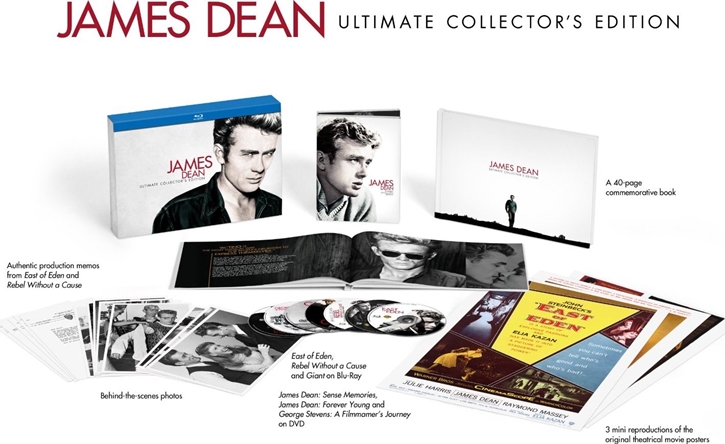
Two feature documentaries are also exclusive to the Ultimate Collector's Edition (and are not found in the separate DigiBook editions):
James Dean: Sense Memories (1.78:1 Anamorphic Widescreen, 53 min.) is an episode of the American Masters PBS documentary series that originally aired in 2005. This episode is all about focusing on Dean. There is an abundance of interviews and background information provided by individuals within the Hollywood elite. This includes recollections from those somewhat familiar with Dean from when he began his acting career to individuals who had worked closely with the actor during production on East of Eden and Rebel Without a Cause.
James Dean: Forever Young (1.33:1, 1 Hr. 28 Min.) is another documentary about the actor. It was narrated by Martin Sheen. In addition to exploring his main feature roles (the iconic ones presented in this beautiful Blu-ray set), the documentary explores his television appearances. There is also information on his love life and other personal details. It's a different type of documentary approach than most of the other James Dean documentaries sprinkled across several discs in the James Dean: Ultimate Collector's Edition.
Below you can find information on the other supplemental materials included with each of the films in the collection:
Giant
The Blu-ray release of Giant retains all of the supplemental features found on the 2-Disc DVD Special Edition. The second disc for Giant (a DVD) is the same one previously included in that edition. This release also adds the addition of a separate DVD of the documentary film George Stevens: A Filmmakers Journey (1 Hr. 51 Min.) which was produced, written, and directed by George Stevens, Jr. as an exploration of his father's career and craft.
On the Feature-Film Blu-ray:
Introduction by George Stevens, Jr. (SD, 3 min.)
Commentary by George Stevens, Jr., Screenwriter Ivan Moffat, and Film Critic Stephen Farber
George Stevens: Filmmakers Who Knew Him (SD, 46 min.) is a documentary featuring several different interviews with directors who knew George Stevens, including Frank Capra, Warren Beatty, and Robert Wise (amongst others). These directors offer up their own insight into the filmmaker, both in terms of his art and his unique personality.
On the Bonus Features DVD:
Memories of Giant (52 min.) is a documentary produced in 1998, and that features interviews with most of the cast and crew and George Steven's son, George Stevens, Jr.
Return to Giant (55 min.) is another documentary about Giant. This one was produced in 2003 and it delves into a lot of similar ground a the first one as it mainly features interviews about Giant, and select film clips.
Two Giant premiere events are covered here: New York Premiere Telecast (29 min.) and Hollywood Premiere (4 min.)
Giant Stars Are Off to Texas (1 min.) is a classic news reel from WB.
Stills and Documents provide both photographs from the making of the film and memos from Giant.
Behind The Cameras: On Location in Marfa, Texas (6 min.)
Behind the Cameras: A Visit with Dmitri Tiomkin (7 min.)
Trailers promoting Giant (both during its original theatrical release and re-release).
There are text-based inclusion on this release: A Giant Undertaking is a text-based walkthrough of George Stevens career as filmmaker, George Stevens Filmography notes his works, Awards details the awards won, and Cast and Crew gives more insight into the careers of others who worked on Giant.
Rebel Without a Cause
The edition of Rebel Without a Cause includes the majority of the supplements from the 2005 Special Edition 2-Disc DVD release. This release also adds a brand new supplemental feature.
Details of the Supplements:
Dennis Hopper's "Memories from the Warner Lot" (HD, 11 min.), a brand new interview for the Blu-ray edition. In this piece, Hopper discusses his work on Giant and Rebel Without a Cause.
Commentary by Douglas L. Rathgeb, the author of The Making of Rebel Without a Cause.
James Dean Remembered (1 Hr. 6 min.) is another documentary about James Dean and featuring interviews with actors he worked with, particularly those involved with Rebel Without a Cause, such as Natalie Wood and Sal Mineo.
Rebel Without a Cause: Defiant Innocents (37 min.) is a documentary chronicling the production of the film.
Screen Tests (6 min.) and Wardrobe Tests (5 min.) are provided.
Several Deleted Scenes are included, and these scenes include both scenes from the black and white filming (from when the film was originally being made in black and white) and color scenes cut from the second phase of filming. All of the scenes are presented without sound.
Behind the Camera features short interviews with James Dean, Natalie Wood, and Jim Backus.
Theatrical Trailer
East of Eden
All of the supplements from the 2005 2-Disc DVD Special Edition have been ported over for the Blu-ray edition of East of Eden, including:
Commentary by film critic Richard Schickel
Forever James Dean (1 Hr.), a documentary about James Dean, as narrated by Bob Gunton.
East of Eden: Art in Search of Life (20 Min.) is a documentary with interviews with various individuals who were involved with the making of East of Eden.
There are also a number of shorter supplements, including: Screen Tests (6 min.), Wardrobe Tests (23 min.), Deleted Scenes (19 min.), and the 3/9/55 NYC Premiere (14 min.) which featured appearances by novelist Steinbeck, director Kazan, and others.
The original Theatrical Trailer is also included.
Final Thoughts:
Dean has a cult status in popularity. He is one of the most cherished actors in film history. The undeniable thing about Dean is that he possessed a massive star-appeal: he was full of the charisma and grace that we find in today's most cherished movie-stars, and he was quite definitively unique as an actor with an immense range that is still quite uncommon.
These films are genuine classics and deserve a spot in any film collection and the new Blu-ray presentations offer enthusiasts the best home viewing options ever made available for Rebel Without a Cause, Giant, and East of Eden. The transfers are significantly improved over the previous DVD editions.
Film buffs will cherish having these films on Blu-ray. Whether the films are purchased in this luxurious set honoring the legacy of James Dean or individually, DigiBook style (as each film was released with a standalone collector's edition release) the transfers and supplements should impress.
Keep in mind, if you want to receive every possible supplemental feature this is probably the best bet as the collection contains DVD's of James Dean: Sense Memories and James Dean: Forever Young, making this a truly 'ultimate' collection for fans of the actor. You also get exclusive memorabilia (as detailed in the 'extras' section of this review).
It's a real treat to have Rebel Without a Cause, Giant, and East of Eden in 1080p HD and fans shouldn't be disappointed. This is an excellent set worthy of our highest accolade, our highly coveted DVD Talk Collector Series.
Neil Lumbard is a lifelong fan of cinema. He aspires to make movies and has written two screenplays on spec. He loves writing, and currently does in Texas.
|
| Popular Reviews |
| Sponsored Links |
|
|
| Sponsored Links |
|
|
| Release List | Reviews | Shop | Newsletter | Forum | DVD Giveaways | Blu-Ray | Advertise |
|
Copyright 2024 DVDTalk.com All Rights Reserved. Legal Info, Privacy Policy, Terms of Use,
Manage Preferences,
Your Privacy Choices | |||||||









